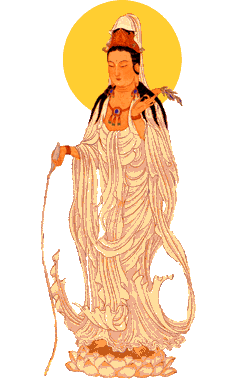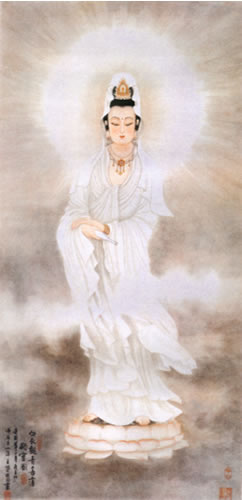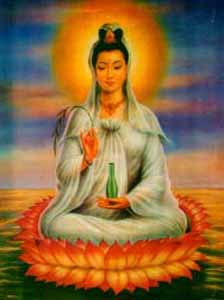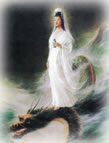Chakras I hope she and I can work together on your chakras.
 Kuan-Yin Kuan-Yin |
Kuan-Yin or Guan Yin Known as one of the “four great Bodhisattva” (Shambala Dictionary of Buddhismand Zen, 119) of Buddhism, Kuan-Yin is an important element of Buddhism. Ever-present in temples and iconography, she is venerated throughout Asia.
| Kuan Yin (also spelled Kwan Yin or Quan Yin and known as Kuan Shih Yin), is known as the Goddess of Compassion & Healing. She is one of the most popular deities in all of Asia. Her name in Chinese roughly translates as “The One who Hears the Cries of the World”. She is the most beloved and revered of the Chinese dieties. Kuan Yin is the Divine Mother we all long for: merciful, tender, compassionate, loving, protecting, caring, healing, and wise. She quietly comes to the aid of her children everywhere. Her mantra is ‘Om Mani Padme Hum.’ (that is, ‘Hail the Jewel -or pearl- in the Lotus.’) Many believe that she is the female representation of Avalokitesvara, who is the Tibetan and Nepalese God of Compassion. In Asia, statues of Kuan Yin can be found in front of, or on the grounds of, many Buddhist temples.
Just as Catholic Christianity has provided an antidote to pure theological patriarchy by encouraging the reverence of the Virgin Mary, so Chinese Buddhism evolved a feminine bodhisattva, or Buddha-to-be, named Kuan Yin. And just as Mary captured the hearts of Catholic worshipers, so Kuan Yin far outstripped the male bodhisattvas in popularity. Both in Japan (as Kwannon, who is often pictured as male) and in pre-revolutionary China, this semidivine being was honored in virtually every home; she was the most powerful being in the entire Chinese pantheon. |
| Kuan Yin is depicted in various forms and poses. She always appears cloaked in white, the color of purity, and her gowns are long and flowing. Often she will be holding a rosary in one hand, a symbol of her devotion to Buddhism and its tenets. She will also have either a book (The Lotus Sutra, which refers back to her origins), or a vase, which symbolizes her pouring compassion on to the world.
Other times, she might be holding a willow branch, which is a symbol of being able to bend (or adapt) but not break. The willow is also used in shamanistic rituals and has had medicinal purposes as well. Often, she will be seen holding a child, a reminder of her role as the patron saint of barren women. Another common appearance of Kuan Yin is one having a thousand arms, with eyes in the palms or holding different objects, such as those mentioned above. Her arms allow her to help stop the suffering of those all around the world, while the thousand eyes help her see anyone who may be in need. (The story of how she got those thousand arms appears below.) Or, you might see Kuan Yin standing with a peacock, since the spread tail feathers of a peacock look like they have eyes in them. |
 |
 |
She might be seated or standing on a lotus blossom, which is one of the main symbols of Buddhist purity, since it a beautiful flower that grows out of mud. The meaning is that our hearts should be pure like the lotus flower, even though our lives might be surrounded by dirty (or impure) people and situations. |
| There are numerous other forms of Kuan Yin throughout Asia; in Japan alone there are 33 different manifestations. You will find shrines dedicated to her not only in China, but in Burma, Cambodia, Indonesia, Korea, Japan, Laos, Malaysia, Singapore, Thailand and Viet Nam. You will find images of her not only at Buddhist temples, but also in Taoist and Confucian temples. |
 |
 |
 |
| The Origin of Kuan Yin:
There are many legends about the origin of Kuan Yin, but this in one of the most popular. In 7th century China, a king had three daughters, the youngest named Miao-Shan. At the time of Miao-Shan’s birth, the earth trembled and a wonderful fragrance and flower blossoms sprang up around the land. Many of the local people said they saw the signs of a holy incarnation on her body. While the king and queen were amazed by this blessing. Unfortunately, they were corrupt and saw little value in a child who appeared pure and kind. When Miao-Shan got older, the king wanted to find a husband for her. She told her father she would only marry if by so doing she would be able to help alleviate the suffering of all mankind. The king became enraged when he heard of her devotion to helping others, and forced her to slave away at menial tasks. Her mother, the queen, and her two sisters admonished her, all to no avail. In desperation, the king decided to let her pursue her religious calling at a monastery, but ordered the nuns there to treat her so badly she would change her mind. She was forced to collect wood and water, and tend a garden for the kitchen. They thought this would be impossible, since the land around the monastery was barren. To everyone’s amazement, the garden flourished, even in winter, and a spring welled up out of nowhere next to the kitchen. When the king heard about these miracles, he decided that he was going to kill Miao-Shan. After all, the nuns who were supposed to have tormented her. But as his henchmen arrived at the monastery, a spirit came out of a fog of clouds and carried her away to safety on a remote island. She lived there on her own for many years, pursuing a life of of religious dedication. Several years later, her father became seriously ill. He was unable to sleep or eat; his doctors believed he would certainly die soon. As he was about to pass, a monk came to visit the king. The monk told the king he could cure the monarch, but he would have to grind up the arms and eyes of one free from hatred to make the medicine. The king thought this was impossible, but the monk assured him that there was a Bodhisattva living in the king’s domain who would gladly surrender those items if asked. The king sent an envoy to find this unknown bodhisattva. When the envoy made the request, Miao-Shan gladly cut out her eyes and severed her arms. The envoy returned and the monk made the medicine. The king instantly recovered. When the king thanked the monk; he chastised the king by saying, “You should thank the one who gave her eyes and arms.” Suddenly, the monk disappeared. The king believed this was divine intervention and after ordering a coach prepared headed off with his family to find and thank the unknown bodhisattva. When the royal family arrived they realized it is was their daughter, Miao-Shan, who had made the sacrifice. Miao-Shan spoke up, “Mindful of my father’s love, I have repaid him with my eyes and arms.” With eyes full of tears and hearts full of shame, the family gathered to hug Miao-Shan. As they did so auspicious clouds formed around Miao-Shan. The earth trembled, flowers rained down, and a holy manifestation of the Thousand Eyes and Thousand Arms appeared hovering in the air. And then, the bodhisattva was gone. To honor Miao-Shan the royal family built a shrine on the spot, which is known as Fragrant Mountain. BODHISATTVA (also spelled Boddhisattva): Literally means “enlightened being”; a soul who, through compassion and altruism, has earned the right to leave this world of suffering and enter nirvana, but has chosen instead to stay on Earth to instruct others to until all beings are enlightened. A Bodhisattva acts as the key figure in Mahayana Buddhism. |
| Literal Translation: |
|
Namo (Sanskrit) – Homage to / Refuge in Guan (Chinese) – Observe / Care Shih (Chinese) – World Yin (Chinese) – Sound / Voice Pusa (Sanskrit) – Bodhisattva |
| Buddhist Gods & Goddesses with their Mantras |
| Om Mani Padme Hum |
| Gayatri Mantra |
| Return to Mantra Main Page |
 HOME
HOME For further information please see our legal page at
http://Circle-of-Light.com/legal.html
This page uploaded to a circle-of-light.com September 8, 2003
Recorded by the Internet Archive History Organization,
supported in part by the United States Library of Congress,
on Dec 22, 2003